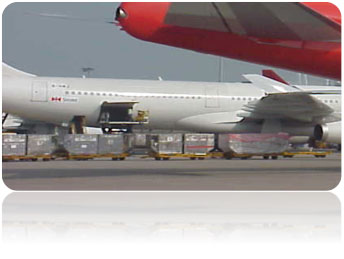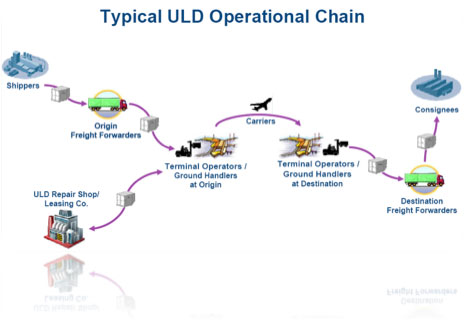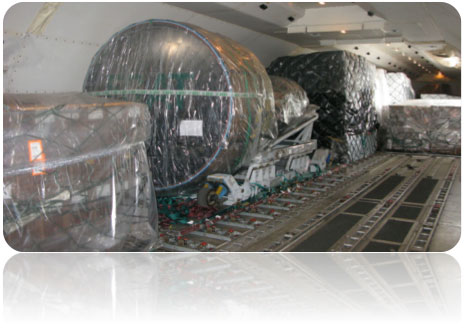Airports, Basics, Cargo Terminals, Freight Forwarders, CARE, Ground Handlers, ULD Service providers
ULD and Responsibility

To a casual observer of airport or air cargo operations ULDs might seem to somehow manage themselves. The view from a gate lounge often includes 20 to 30 ULDs of different shapes and sizes around the aircraft on dollies or being loaded into the aircraft in what may appear to be a rather haphazard manner.
How wrong they would be. Not a single step of ULD operations should ever be left to chance. The apparently chaotic scenario should in fact be one part of a totally defined and controlled process. The objective of the process is to ensure that cargo and baggage is secured on the aircraft in a manner that will NEVER be a risk to the safety of the aircraft, its passengers and crew.
The operation of any ULD is subject to a series of well documented procedures and any person or organization working with ULDs at any point cannot escape their responsibilities to comply with these procedures 100% of the time.
The topmost responsibility will always lie with the airline, as it’s their aircraft that takes to the air. When the doors close and the engines are started, 100% of the responsibility for flight safety lies on their shoulders. Cabin crew takes the passengers through a pre-flight safety briefing that includes requiring them to secure their seat belts and carry-on baggage. Their preflight checks also ensure that everything is secured correctly in the galleys as well as below in the cargo hold. If all procedures have been followed properly, 20 to 30 ULDs loaded with many tons of cargo and baggage should be ready to perform their task of securing their contents for the duration of the flight through whatever turbulence and flight maneuvers may occur. These processes, in the cabin and in the cargo hold, are essential components of flight safety.
Who requires all this? Where is it written down? The answer is that all requirements related to aircraft loading are contained in the Weight and Balance Manual (WBM), a thick document produced by the aircraft manufacturer that comes along with the aircraft and details all the required processes and procedures.
Who is responsible for complying with the WBM? The answer is the airlines which, regardless of any kind of use of contractors/ service providers to deliver any services related to the aircraft or its equipment, remain ultimately responsible for operating their aircraft in compliance with the WBM.
Wind the clock back 30-40 years, this process was all pretty straight forward. Airlines either carried out their own ground handling or subcontracted the process to another airline. Indeed, in the 60’s and 70’s, most airlines had substantial in house ground operations departments that handled their own and other airlines’ aircraft. Today, in the vast majority of cases, ground handling, cargo loading and other ground based operations have been outsourced to a multitude of service providers, large and small. Some providers may be affiliated with an airline, but for many it’s very much an arms-length relationship.
The key difference here is that while commercially such outsourcing can be attractive, it has created a separation between the airlines, with their competence and responsibility for the WBM procedures, and the people who actually perform the services. This is made worse by the fact that, for various reasons, the WBM’s are not permitted to be circulated by the airlines to their service providers. Instead the airlines have to try to convey the requirements of the WBM to service providers through their own documentation.
What happened to the responsibility issue with this development? The answer is less than clear. Service providers are, of course, bound by all sorts of contractual agreements with their customers. And no doubt maintaining compliance with the WBM is part of such agreements, but just how clearly is this understood at a detailed level – like front line operations? In 1997 Fine Air Flight 101 crashed on takeoff with the loss of life of 5 crew and bystanders. The investigation uncovered failings resulting from insufficient understanding between the contracted service provider and Fine Air in regard to cargo loading including some specific ULD functions.
Is there another Fine Air in the making right now? Has the industry changed its ways?
The recently published IATA ULD Regulations (ULDR) tackles this head on. Taking a leaf out of the widely used IATA Dangerous Goods Regulations (DG), the ULDR (Section 1.4-1.5) establishes responsibilities for both the airline (operator) and “other parties”. In DG there are only 2 “other parties”, the shipper and the forwarder, but in the ULDR, due to the wide range of different organizations who may have some interaction with ULDs, there are no less than 15 different parties having defined responsibilities.
The typical operational chain for ULDs, as widely circulated in this IATA schematic, illustrates just how many different parties may at some time or other play a role in ULD operations. The critical point here is that each of these parties must fulfill their responsibilities correctly if the airline, as the ultimate responsible party, is to be able to meet its obligations to comply with the WBM.

To summarize:
- Airlines can never ever relinquish their responsibility to operate their ULDs safely, regardless how much they may outsource their activities
- Service Providers must never fail to meet their obligations to perform their ULD related services, regardless of the costs involved.

Responsibility for safety in aviation is a give and none of us would wish to fly on an unsafe aircraft. Responsibility for safety in ULD operations is one component of this picture. Through the publication of the IATA ULD Regulations, the industry now has an excellent new tool to work with. ULD CARE is working to facilitate the adoption of these responsibilities. It now lies with the industry to accept and integrate into their operations their defined responsibilities.
Outsourcing of ground handling and other ULD related activities is with us to stay. It is very important that the entire industry supports the airlines in achieving 100% compliance with their Weight and Balance Manuals.
Though it might seem convenient to believe otherwise, there is no kind of commercial arrangement that can ever take away the airline’s responsibility for using only ULDs that are maintained and operated according to the requirements of the WBM on board their aircraft. The rest of the industry, while they may not have a direct WBM compliance responsibility, must play its role in supporting the airlines in this important function.



Comments are closed.